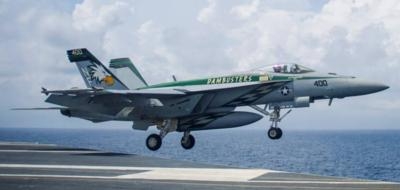Trained Above Key Battlegrounds From WWII With Modern Aircraft
Aircrew from Carrier Air Wing Five (CVW 5) had the unique opportunity to experience storied World War II history during the 17-1 patrol cycle aboard USS Ronald Reagan (CVN 76), July 31.

To commemorate the significance of the Solomon Islands, CVW-5 executed heritage flights over several of the key battlegrounds from these pivotal campaigns, allowing CVW-5 aviators to train to their modern-day mission skillsets, while also gaining first-person perspective on lessons learned during these historic campaigns.
"The heritage flights provide historic perspective for the aircrew who were fortunate enough to take part in them, connecting today's naval aviators to the heritage of the past while honoring those who fought valiantly during the Solomon Islands campaign," said Cmdr. Ryan Jackson, commanding officer of Strike Fighter Squadron (VFA) 195. "The lessons learned carry forward into our mission today and into the future."
Led by VFA-195 and launching from USS Ronald Reagan (CVN 76), CVW-5 aircrew began the flight route at Viru Harbor on the southern part of New Georgia Island. During late June of 1943, US Marines defeated Japanese troops guarding Viru Harbor, driving them from Viru and reinforcing the harbor with additional US forces.
From Viru Harbor, the route led north to Rendova Island, which housed a major base for US PT boats during the conflict. After Lt. j.g. John F. Kennedy's PT boat (PT 109) was struck by the Japanese destroyer Amagiri, the crew was stranded on Plum Pudding Island (now commonly referred to as Kennedy Island). Solomon Islanders aided in the crew's rescue by paddling canoes 35 miles from Plum Pudding Island to Rendova Island to deliver a message inscribed on a coconut from Kennedy. The heritage flight route also included Kennedy Island where a small shrine to Kennedy, built by a Solomon Islander who aided in the rescue of the crew, still stands.
After Rendova Island, the route continued towards Munda Airfield and Vila Airfield. The Japanese base at Munda on New Georgia Island was the main objective of the assault on the island. U.S. forces secured the base after six weeks of fighting on August 5, 1943. Vila Airfield on Kolombangara Island was a frequent target for U.S. bombers. However, it remained in service until the Japanese evacuation of the island in September 1943.
The route then proceeded on towards Vella Lavella Island. The Battle of Vella Lavella lasted from August 15 - October 9, 1943 between Japan and Allied Forces from New Zealand and the United States. After capturing the island, it became the home base for VMF-214 "Blacksheep" and the famous World War II ace, Major Gregory "Pappy" Boyington. This historical flight route ended at Vella Lavella Island where Allied Forces secured the central Solomons region prior to continuing north with the attack on Bougainville.
The Solomon Islands saw fierce fighting between the United States and the Empire of Japan in a campaign that lasted more than seven months, including the famous Battle of Guadalcanal. This campaign was a decisive victory for the Allies in the Pacific theater, proving to be a turning point in the war.
The campaign lasted from August 7, 1942 through February of 1943. Beginning with amphibious landings on Guadalcanal and the capture of Henderson Field as a base from which the United States could project air power. The campaign also included famous naval battles. With a series of surface naval engagements including the Battle of Savo Island and Cape Esperance culminating in the Naval Battle of Guadalcanal, the US Navy secured maritime superiority in the region. This allowed the relief of the First Marine Division, who saw heavy fighting on Guadalcanal, along with additional U.S. Army personnel. Two major carrier battles were also fought during the campaign, the Battle of the Eastern Solomons during August of 1942 and the Battle of the Santa Cruz Islands during October of 1942. The two carrier battles depleted the Japanese of experienced naval aviators. Unable to adequately replace the losses, the Japanese were ill-prepared for later carrier battles including the Battle of the Philippine Sea. After
U.S. forces seized the initiative in the South Pacific through months of brutal land and sea warfare during the Solomon Islands campaign, they continued to advance via the island-hopping campaign which eventually led to victory in the Pacific.
Beginning in June 1943, the US continued its liberation of the Solomon Islands with the New Georgia Campaign. Historic battles at Viru Harbor, Munda Airfield, and Vella Lavella Island followed as allied forces continued to engage in fierce fighting with the Japanese. These battles lasted until October 1943 when Allied Forces had secured the central Solomons region.
The fighting in the Solomon Islands proved to be a turning point in the Pacific theater for Allied Forces as it marked the transition from defensive operations to an offensive campaign.
The mission to support Allied interests in the Indo-Asia-Pacific remains unchanged and connects CVW-5 to those who fought these fierce battles in the Solomon Islands.
(U.S. Navy image)
 Airborne 04.16.24: RV Update, Affordable Flying Expo, Diamond Lil
Airborne 04.16.24: RV Update, Affordable Flying Expo, Diamond Lil ANN's Daily Aero-Term (04.20.24): Light Gun
ANN's Daily Aero-Term (04.20.24): Light Gun Aero-News: Quote of the Day (04.20.24)
Aero-News: Quote of the Day (04.20.24) Aero-News: Quote of the Day (04.21.24)
Aero-News: Quote of the Day (04.21.24) ANN's Daily Aero-Term (04.21.24): Aircraft Conflict
ANN's Daily Aero-Term (04.21.24): Aircraft Conflict



